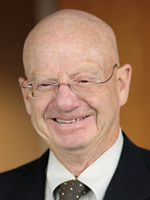Amy Carpenter Aquino
September 2017—Those who have seen the strength of antibiotic stewardship hope the FDA’s clearance this year of an assay for antibiotic management will drive further and move faster the efforts being made to curb unnecessary use.
“Hopefully, it will infuse confidence into caregivers as far as trusting the results,” says David Gilbert, MD, chief of infectious diseases at Providence Portland (Ore.) Medical Center, of the BioMérieux Vidas Brahms procalcitonin assay. The FDA in February cleared the test for expanded use in determining when it’s appropriate to start and stop antibiotics for lower respiratory tract infections and when to stop antibiotics in patients with sepsis.
Daniel Feinstein, MD, critical care services director at Cone Health, Greensboro, NC, calls procalcitonin a “major pillar” of antibiotic stewardship. He has been using the BioMérieux Vidas Brahms PCT assay to measure procalcitonin levels in sepsis and lower respiratory tract infection patients as part of his hospital’s antibiotic stewardship program since 2010.
“We as a country do a horrible job at antibiotic management, and it’s reflected in C. difficile and other catastrophic problems that we have in our hospitals and our communities,” Dr. Feinstein says. “Now we have the FDA clearing a product like the Vidas procalcitonin to be an integral part in antibiotic stewardship and allowing physicians to de-escalate and even discontinue or shorten the duration of antibiotics with a lot more confidence, in an algorithmic fashion.”
“I think it’s always crucial for clinicians to be able to use products, whether it’s an antibiotic or a lab assay, that have been studied,” he adds. The BioMérieux Vidas assay has been studied for long periods and does not produce interactions with dietary supplements, such as biotin, Dr. Feinstein says. “If you have another product, you don’t have the confidence you would with the particular Vidas assay” for antibiotic management.
BioMérieux’s Vidas assay has the additional advantage of a high-level range of measurement of up to 200 ng/mL to assist clinicians in assessing the trend of a patient with a very high PCT level, he says. “Let’s say you have a procalcitonin assay that only goes up to 100 or 80. You may have someone who, three days in a row, has procalcitonin greater than 100, but you don’t know which direction it’s going, up or down. It’s the trend of the procalcitonin that’s what’s most important in taking care of patients, in terms of antibiotic stewardship.”
Physicians using the Vidas PCT assay at Cone Health have reduced antibiotic use in ICU patients by an average of more than four days per patient, Dr. Feinstein says.
He describes a patient in his 30s who had what appeared to be cellulitis in a lower extremity. The patient came into the emergency room in shock and coded. Once the patient was given antibiotics, he woke up and started talking and his blood pressure improved, but not completely. Continued monitoring showed the patient’s procalcitonin level starting to flatten and rise. At that point, physicians became more aggressive in terms of source control.

Dr. Feinstein
“Based on the flat clinical progress, but also the procalcitonin—which really blew my mind—he ended up having an active soft tissue infection and needed surgery and amputation,” Dr. Feinstein says. After surgery, the patient “clinically progressed, and the procalcitonin went down substantially after we pushed forward with more aggressive source control.”
Demonstrating the benefit of procalcitonin measurement to lower respiratory tract infection patients, Dr. Feinstein points to a patient in his 70s who recently came into his ICU described as having hospital-acquired pneumonia. “He was on pressors because he was hypotensive and he had an elevated lactic acid level.” The patient’s x-ray could have been consistent with heart failure, and his condition rapidly improved. “Pneumonia usually doesn’t act like that. And his procalcitonins were negative for all three days.”
Dr. Feinstein discontinued antibiotics at the 72-hour mark. “He was extubated and is clinically progressing, so I’m not going to give him a risk for C. diff anymore, because he doesn’t need the antibiotics. The procalcitonin certainly assisted me in de-escalating.”
Procalcitonin’s limitation is inter-patient variability, which is the main limitation of using PCT for antibiotic stewardship and one “everyone has to recognize,” he says.
“If you have pneumonia and sepsis, and I have pneumonia and sepsis, your value might be 56 and mine’s 26. We do know within each host it will continue to rise and be very, very high and rise as you get more acutely ill. So within each host it’s more reliable.”
“You just have to recognize that trend is important,” Dr. Feinstein continues. A physician may examine an emergency room patient who has a negative procalcitonin, “but if everything looks and smells like septic shock, you continue to treat them with antibiotics and with your clinical know-how. Follow their trend.”
The FDA clearance of the Vidas assay should pave the way for more procalcitonin testing in more hospitals and greater collaboration between the laboratory and clinicians, Dr. Feinstein says. “This is a good example of us both recognizing the need for the care of the patient. We need everyone to do this the best we can, and we can’t do it without our laboratory colleagues.”
Grady Memorial Hospital in Atlanta has a simple algorithm for procalcitonin testing, says Yun F. (Wayne) Wang, MD, PhD, Grady’s director of microbiology, immunology, and molecular diagnostics. Dr. Wang conducted a clinical study with infectious disease and critical care doctors and pharmacists to evaluate PCT levels in patients admitted to the medical and surgical intensive care units. They presented their data at the American Society for Microbiology annual meeting in 2012. With input from the clinical laboratory, pharmacists, and infectious disease and critical care clinicians, Grady Memorial implemented its procalcitonin testing algorithm in 2013. The numbers for procalcitonin testing have been stable ever since.
“We created the algorithm for use of procalcitonin mainly for the medical intensive care unit,” Dr. Wang says. “We said, ‘We need to look into any suspected infection, sepsis, and any antibiotic therapy initiated. Then PCT will be ordered and tested.’ Clinicians are expected to look at the daily review of culture with antibiotic de-escalation according to the organism modification, evaluate the PCT levels, look at clinical correlation, and consider stopping antibiotics.”
Grady’s sepsis working group is exploring how to integrate procalcitonin testing into the sepsis code that was introduced to the emergency room in 2016 and expanded to inpatient floors this past April.

Dr. Wang
“Hopefully we will be able to standardize PCT testing and have more serial testing, mostly for the prognosis and for antibiotic stewardship to de-escalate and stop the antibiotics if the patient suspected of sepsis is recovering,” Dr. Wang said.
Grady has not promoted procalcitonin testing for treatment of lower respiratory tract infection, though tests for it have been ordered through the emergency department and other places, Dr. Wang says. “We just recently reviewed a few cases,” he says. “We are in the process of discussing this with our antibiotic stewardship team, how to reevaluate the process and implement establishment of guidelines.” Dr. Wang envisions the procalcitonin test becoming part of a general order set.
He shared a recent case of a 29-year-old man who was admitted to the hospital through the ED with acute respiratory failure and altered mental status. His procalcitonin level was 57.47 ng/mL, and his respiratory culture grew methicillin-resistant Staphylococcus aureus. He was treated for MRSA, but four days later the patient still had a procalcitonin level of 21.19 ng/mL. This time, his respiratory culture grew susceptible Acinetobacter baumannii and E. coli, and four days later the patient developed C. difficile colitis. After treatment for the C. difficile colitis, his procalcitonin level was down to 3.32 ng/mL.
A clinical study in Grady’s surgical divisions is looking now at the potential role of procalcitonin in the decision to administer antibiotics to patients after abdominal surgery.
“People have a lot of interest to see where this biomarker can be used,” Dr. Wang says. “The bottom line is we may need more data.”
For physicians at St. Anthony Hospital in Oklahoma City, a shorter response time increased the appeal of using the procalcitonin assay for antibiotic decisions, says John M. Hurst, PharmD, BCPS-AQ-ID, director of antibiotic stewardship.
When Dr. Hurst arrived at St. Anthony Hospital in March 2015, the hospital was sending procalcitonin tests to ARUP Laboratories. “For a rapid turnaround test, it wasn’t ideal and utilization was low,” says Dr. Hurst, who had used procalcitonin successfully in stewardship practice in a former position at the Medical University of South Carolina.
Dr. Hurst approached St. Anthony’s laboratory administrators, pathologists, and infectious disease physicians and requested that they consider bringing the procalcitonin assay in-house; a compromise brought the assay to a laboratory at a nearby facility within the city. “Our use dramatically increased once we could get a turnaround time that was reasonable,” Dr. Hurst says. “With the increased volume, they said, ‘We’ve got to bring this test in-house immediately.’ That’s when we brought it in on the Vidas 3 machine.”
Now that the assay is in-house, “we see our hospitalists ordering it around the time of their first assessment and trying to make a decision on what the ER has started,” Dr. Hurst says. The FDA clearance of the Vidas assay “really gives us the ability to point toward this biomarker as something that has a stamp of approval,” he adds.
Some St. Anthony clinicians are already fully on board and users of the assay, while others are holdouts. “Now that we have some larger studies that demonstrate a benefit and consistent performance, I think we’re able to reengage those clinicians in the conversation and point toward the framework that was approved by the FDA for sepsis recognition and de-escalation of antibiotics for sepsis, as well as the initiation and discontinuation of antibiotics for lower respiratory tract infections,” Dr. Hurst says.
On the day that Dr. Hurst spoke with CAP TODAY, he was reviewing a case of a woman in her early 60s who presented to the ED with COPD and possible pneumonia, as well as esophagitis and dysphagia. Her complex medical history included diabetes, hepatitis C, cirrhosis, and COPD. The patient had not been able to swallow water or food, had a history of esophageal varices that were banded, and had blood-tinged emesis.
“Her vitals aren’t anything that we would think sepsis for—they’re very stable,” Dr. Hurst says. “She’s clear to auscultation bilaterally: no rhonchi, no rails, no wheeze. But we do a chest x-ray and there’s some COPD with some chronic interstitial findings, and they actually end up doing a chest CT in which they describe some findings that are likely infectious or inflammatory in etiology.” After starting the patient on Levaquin in the ED for the CT findings, physicians moved her to a general ward. While working up the patient’s dysphagia, the admitting team checked her procalcitonin with an eye to de-escalate her antibiotics and put her on treatment for COPD.
“With the negative finding today of the procalcitonin being less than 0.05 ng/mL, the stewardship team will be actively following the case and recommending cessation of antibiotics,” he says.
Dr. Hurst points out that the physician’s notes on the patient included a line about ordering procalcitonin and de-escalating Levaquin if the results were negative. “They’re acutely aware of it now, and they’re utilizing the test to start moving us toward a spot where we’re not locking people into seven, eight days of antibiotics for some of these respiratory issues,” he says.

Dr. Hurst
Widespread overuse of antibiotics for respiratory infection continues, but “this has given us a structure in which to approach making it more appropriate,” Dr. Hurst says. “If we can change the paradigm and get away from the old football scores of treatment—six, seven, 10 days of therapy—and using a procalcitonin level to say, ‘I think that whatever was going on has improved,’ we don’t necessarily need to go to seven days or 10 days. At day three, that might be enough for this respiratory infection that maybe wasn’t that serious and had been taken care of with just a couple doses of antibiotics. Or maybe they were never necessary to begin with, and we are able to stop altogether.”
St. Anthony’s also uses the Vidas assay to assess the potential for de-escalating antibiotic therapy in sepsis patients. “There’s that patient who’s kind of smoldering, if you will,” Dr. Hurst says. “They’re really sick and you’re not sure if they’re getting better, you’re not sure if they’re getting worse. [Procalcitonin] gives us a marker to follow and say, ‘Are things headed in the right direction? Is there potential we need to switch antibiotics and either broaden coverage, or are we on the right path and we confirm that we don’t need to start additional antibiotics?’”
“This does not replace clinical judgment,” Dr. Hurst adds.
The case of the patient with COPD is one case among many in which physicians at St. Anthony’s are using a PCR assay to identify pathogens and coupling the PCR result with procalcitonin to have the data they need to stop antibiotic use, Dr. Hurst says. “If you have influenza or a parainfluenza or coronavirus detected by respiratory PCR, and you have respiratory symptoms, seeing procalcitonin at that undetectable range [<0.05 ng/mL] gives us a lot more confidence in being able to say this isn’t a post-viral bacterial pneumonia, we can hold off on starting antibiotics.”
The FDA clearance of BioMérieux’s stewardship claims should convince more physicians to use procalcitonin testing for lower respiratory tract infection patients, says Dr. Gilbert of Providence Portland Medical Center.
“Based on the fact that the FDA reviewed all the available literature, both international and studies from the United States, the FDA agreed there’s a substantive body of knowledge that makes the assay worthwhile and that you can trust the results.” That is, “If there’s a normal procalcitonin and the patient has acute exacerbated chronic bronchitis, the likelihood the patient has a bacterial infection is somewhere under five percent, three percent—very, very unlikely.”
In 2008, Providence Portland Medical Center was struggling, as was the rest of the country, with antibiotic stewardship, “in particular the overuse of anti-infectives for both upper and lower respiratory tract infections,” Dr. Gilbert says.
Most pressing, though, were patients admitted to the hospital with community-acquired pneumonia. Dr. Gilbert believed so strongly in the promise of procalcitonin to help combat the infection that he initiated a series of three studies sequentially correlating procalcitonin levels with the microbiologic cause of the patient’s respiratory tract infection.

Dr. Gilbert
“We wanted to know why it was that physicians, academicians, who have been trying for years and years to determine the etiology of community-acquired pneumonia were painfully inadequate in their attempts,” he tells CAP TODAY. Limiting the attempts to sputum culture and sensitivity and blood cultures led to discovery of the cause of pneumonia in only roughly 20 percent of patients on average. Adding urine tests and looking for the urine antigens Legionella pneumophila and Streptococcus pneumoniae increased the diagnostic yield by an additional 10 or 15 percent.
“That’s where we were,” Dr. Gilbert says, “and the first thing that was obvious was the patients who are sick enough to get into the hospital often cannot produce a sputum. If we intubate them, then of course we can get secretion from the airway, but if they’re sick and weak, they have trouble giving us a sputum.”
“We had to do better,” Dr. Gilbert says. “So we created a diagnostic bundle.” The bundle was sputum, if available, blood cultures, urine antigens, PCR nasal swabs for pneumococcus and Staph aureus, the BioFire respiratory multiplex PCR panel for 17 viruses, and one or two serum PCT levels.
“We had a much bigger net, if you will, looking for pathogens. With that, plus the procalcitonin, we identified the etiology, especially separating bacterial from virus, in 70 percent of patients,” Dr. Gilbert says.
The results of the first two studies were virtually the same and have been published (Gelfer G, et al. Diagn Microbiol Infect Dis. 2015;83:400–406 and Gilbert D, et al. Diagn Microbiol Infect Dis. 2016;86:102–107). A third, larger study is underway, this time using a second-generation BioFire multiplex PCR panel with 40 targets. Dr. Gilbert predicts the results will drive pathogen detection above 70 percent.
“Of course, that has a dramatic impact on customizing the antibiotic regimen for the patients, and the duration of therapy is much less,” he says.
As results from the first two studies were shared locally and then in the literature, he says, enthusiasm for procalcitonin testing among physicians at Providence Health medical centers rose.
In illustrating procalcitonin’s clinical utility, Dr. Gilbert describes a hypothetical type of patient with chronic obstructive pulmonary disease. Such patients, who are often colonized, especially with the pathogens Haemophilus and then less often with pneumococcus and Moraxella, come into the hospital with an acute exacerbation of their COPD and possible pneumonia. “We do our bundle and we find Moraxella or pneumococcus or Haemophilus, but their procalcitonin is normal. That proves to us that those potential pathogens are colonizing and not invading, and hence there’s no need for antibiotic therapy.”
[hr]
Amy Carpenter Aquino is CAP TODAY senior editor.